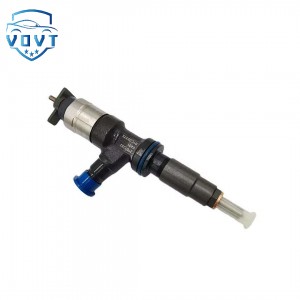New High Quality Diesel Nozzle G3S2 for Injection Nozzle Diesel Engine Parts
Products Description
| Reference. Codes | G3S2 |
| Application | / |
| MOQ | 12PCS |
| Certification | ISO9001 |
| Place of Origin | China |
| Packaging | Neutral packing |
| Quality Control | 100% tested before shipment |
| Lead time | 7~15 working days |
| Payment | T/T, L/C, Paypal, Western Union, MoneyGram or as your requirement |
The role of the fuel injector
Precisely control the amount of fuel injection
1. Dynamically adjust the amount of fuel injection according to the working conditions
Principle:
The fuel injector controls the opening and closing of the needle valve through the power on/off (or voltage signal) of the electromagnetic coil or piezoelectric crystal, and accurately controls the amount of fuel injected each time according to the pulse width (duration) of the electrical signal sent by the engine ECU (electronic control unit).
Scenario example:
Idle condition: small amount of fuel injection (about 5-10mg/cycle), maintaining the minimum speed;
Full load acceleration: the amount of fuel injection can reach 5-8 times that of idle speed to meet the power demand;
Deceleration and coasting: the amount of fuel injection drops sharply or even stops, reducing fuel waste and emissions.
Technical value:
Compared with traditional carburetors, the control accuracy of the fuel injection amount of the electronic fuel injection system is improved to within ±1%, fuel consumption is reduced by 10%-15%, and pollutant emissions (such as CO, HC) are reduced by 30%-50%.
Achieve fuel atomization and mixing
1. Break the fuel into fine particles
Structural design:
The head of the fuel injector usually has 1-12 fine spray holes (aperture 0.1-0.3mm, and direct injection engines are even smaller). When the fuel passes through the spray holes under high pressure (about 0.3-0.6MPa for manifold injection, and 10-35MPa for direct injection), it is atomized into droplets with a diameter of 10-100 microns due to high-speed flow and air friction.
Key functions:
Increase the contact area between fuel and air, accelerate evaporation to form a combustible mixture;
The atomization quality directly affects the combustion speed and completeness. Poor atomization will lead to incomplete combustion, increased carbon deposits, and increased fuel consumption.
Comparative differences:
Manifold injection fuel injector: The atomized particles are larger (about 80-100 microns) and need to rely on the intake airflow for further mixing;
Direct injection fuel injector: The atomized particles are finer (about 10-30 microns), which can directly form a homogeneous or stratified mixture with air in the cylinder.
Cooperate with the ignition system to achieve reliable combustion
1. Control the injection timing and injection position
Injection timing:
Manifold injection: injection before the intake valve opens (such as the early stage of the intake stroke), the fuel enters the cylinder with the air;
Direct injection: injection at the end of the compression stroke, using the piston top pit and air flow movement to form a stratified mixture to achieve "lean combustion" (the air-fuel ratio can reach more than 25:1).
Ignition coordination:
The injection timing is precisely matched with the spark plug ignition timing (such as injection advance angle control) to ensure that the mixture reaches the best combustion state at the end of compression, avoiding abnormal combustion such as pre-ignition and detonation.
Adapt to different fuel types and emission requirements
1. Support diversified fuel injection
Gasoline injection: needs to meet the atomization requirements of highly volatile fuels, and the injector has a fast response speed (opening/closing time <1ms);
Diesel injection: needs to withstand higher pressure (up to 200MPa or more), finer spray holes and wear resistance (mostly made of cemented carbide);
Alternative fuels: such as CNG (compressed natural gas) and LPG (liquefied petroleum gas) injection systems, the injector needs to adapt to the flow characteristics of gas fuels.
2. Meet strict emission regulations
Stratified combustion technology: Direct injection injectors achieve "stratified mixture" (thicker near the spark plug and thinner on the periphery) by precisely controlling the spray shape (such as cone, fan shape) and landing point, reducing fuel consumption and NOx emissions;
Multiple injection strategy: 2-5 injections are performed in the same stroke (such as pre-injection + main injection + post-injection), optimizing the combustion phase and reducing particulate matter (PM) and nitrogen oxide (NOx) emissions.
Maintenance and care recommendations
Clean the injectors regularly:
Use fuel additives (containing polyetheramine PEA) every 20,000-30,000 kilometers to dissolve the carbon deposits on the injectors;
If the blockage is serious, it needs to be removed and treated with an ultrasonic cleaner, or the assembly needs to be replaced directly.
Use high-quality fuel:
Poor-quality fuel has high sulfur content and many impurities, which can easily cause corrosion and blockage of the injectors. It is recommended to choose fuel products from regular gas stations.
Pay attention to abnormal signals:
When the idle speed is unstable, the acceleration is frustrated, and the fuel consumption is inexplicably increased, check the working status of the injectors in time;
Avoid long-term low-load operation of the engine (such as idling for more than 3 minutes) to reduce carbon deposits.





















